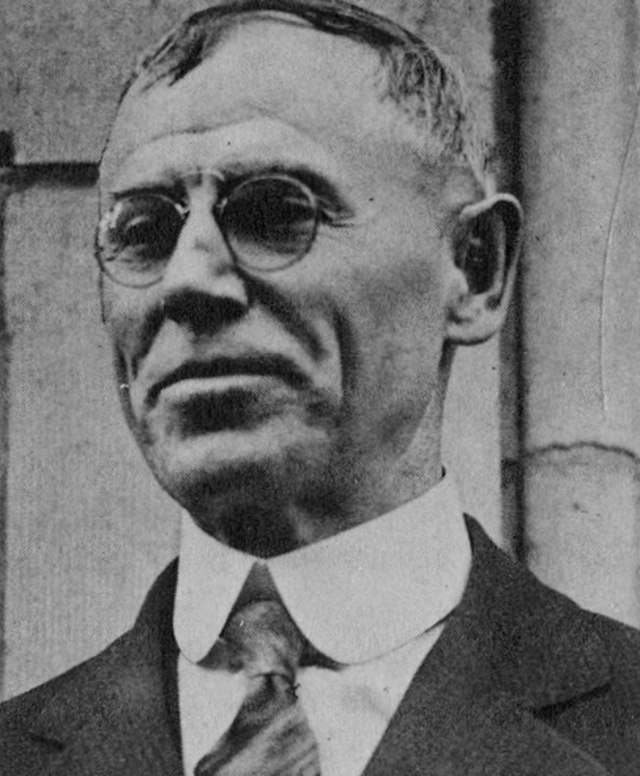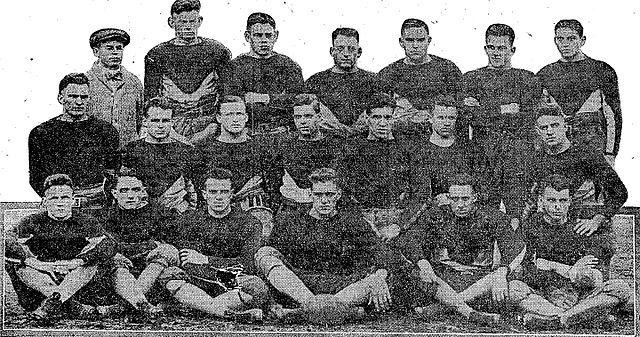What if I told you that the most famous individual football player award was named for a guy from Western Pennsylvania? Well, indeed it is as in this episode we bring you something special from our Western Pennsylvania Football history profile of the week. John Heisman, yes the coach that College Football’s most prestigious Trophy is named after is our subject in this edition
John Heisman
Heisman Bio

John Heisman while at Georgia Tech, courtesy Wikimedia Commons
The first place I am going to grab the biography of Coach Heisman is from the website that bears his name, Heisman.com.
He was born in Cleveland, Ohio, October 23, 1869. His God given name was John William Heisman The Titusville Herald shares that John Heisman’s family name was originally “Von Bogart.” Michael Von Bogart, John’s father, was the son of a French nobleman. Michael chose to marry a peasant girl, Sarah Ann Lehr Heisman, and was subsequently disowned by Baron Von Bogart, the family patriarch. In a Romantic story the young man gave up everything and the marriage took place. With his family turning their back upon him, Michael Von Bogart relinquished his family name and adopted his wife’s family name. Emigration to the United States soon followed, and the young couple settled in Cleveland, Ohio, where Michael Heisman worked as a cooper or barrel maker.
John William Heisman, third son of Michael and Sarah Heisman. Shortly after John’s birth the Heismans moved to Titusville, Pennsylvania where Edwin Drake’s oil well created an the oil boom. The are had need for barrel manufacturers so Michael Heisman opened a cooper shop, which supplied packaging to nearby oil refineries. John Heisman attended a couple of Titusville elementary schools, and was remembered for having enjoyed bobsled riding and frolicing in the town's streets with other youngsters.
He also played in Oil Creek and Church Run. The Titusville High School’s first football team was founded in 1884 and John Heisman became involved with the game at that time according to a piece written almost 100 years later.
“After three local boys returned from college and showed the high school players a more civilized version of the game than they were accustomed to playing, Heisman bought a rule book for 10 cents and ‘retired to seclusion.’ There he labored over such puzzling terminology as ‘touchdown,’ ‘safety’ and ‘offside.’”
“Heisman later reported that the high school team had little use for the ‘fuzz-buzz’ of the official rules. Instead, the 15 - man team ‘had the time of their lives assaulting a (round) black rubber ball up and down expansive fields. The ball belonged to whoever was strong or fleet enough to take it.”’
Not much is known about the Titusville High School football’s 1884-1886 formative years. The only information existing on the school’s football during its first three years are John Heisman’s own written recollections and a brief 1885 Titusville Herald item. The Herald mentioned that a high school team had been formed and that one of its members was “William Johnson.” Perhaps this was a misspelling of “John Heisman,” whose name was sometimes written (or listed) as William J. Heisman.
Michael Heisman refused to watch his son play football, calling the sport “bestial.” Little did he know.
John Heisman’s 1884-1886 recollections mention that the football fields of those years were 110 yards long, instead of the standard 100 yards, long familiar to players and fans alike. Teams sometimes played games three days in a row in order to cover expenses.
League play (with such high schools as Warren, Corry, etc.) did not start until 1902. Part-time and full-time faculty coaches came decades later.
John W. Heisman graduated from Titusville High School, Class of 1887. The June 18, 1887 account of commencement exercises held at the Presbyterian Church mentions the future coach:
“William J. Heisman’s oration - ‘The Dramatist a Sermonizer’ - was full of dramatic emphasis and fire, and showed how the masterpieces of Shakespeare depicted the ends of unchecked passion.... Mr. Heisman’s effort was greeted with well-merited applause.”
In 1887, at age 17 he left Titusville for Brown University where he played a form of club football with his classmates. After two years, in the fall of 1889, he transferred to The University of Pennsylvania to pursue a law degree. Though outsized at 5’8” and 158lbs, he played varsity football for three years as guard, center, tackle, and sometimes end.
An eye injury forced Heisman to abandon his law career plans. He subsequently became Oberlin University’s first head football coach, compiling a perfect debut season.
John Heisman coached college football for 35 years. His football career took him to positions at Bechtel (University of Akron), Alabama Polytechnic Institute now known as Auburn, Clemson, University of Pennsylvania, Washington & Jefferson and Rice. His most impressive coaching reign was with Georgia Tech (1904-1919), where his Golden Tornadoes were a scoring powerhouse with an astounding 33 straight wins. Coach Heisman left Georgia Tech after the 1919 season to return as head coach at his alma mater, University of Pennsylvania. After three years he bought out his contract and spent one year at Washington & Jefferson before moving west to Texas and Rice Institute. His coaching career ultimately spanned more than three decades, and in 1927 at age 62, John W. Heisman retired from coaching the game he loved and developed.
He is remembered for holding up a football on opening day of fall practice, and describing it as “an elongated spheroid-that is, an elongated sphere-in which the outer leathern casing is drawn tightly over a somewhat smaller rubber tubing. Better to have died a small boy than to fumble this football.”
Men who respected and called John W. Heisman friend included coaches Robert C. Zuppke of Illinois, Fielding Yost of Michigan, Amos A. Stagg of Chicago, Dr. J.W. Wilce of the Ohio State University, D.X. Bible of Texas A&M; legendary sports writer Grantland Rice; golf’s first Grand Slam winner Robert Jones Jr.; and former teammate and Honorable Mayor of Philadelphia Harry A Mackey.

Photograph Courtesy of Wikimedia Commons is of the 1917 Georgia Tech Golden Tornado football team, published in the New York Times.
Top row (left to right): Charles Wahoo, John W. Heisman, William F. Thweatt, William C. Mathes, William Higgins, Dan Whelchel, William Fincher, Ray S. Ulrich
Middle row (left to right): Charles Johnson, George Phillips, Joe Guyon, John Rogers, Hamilton Dowling, Alton R. Concord, Robert S. Bell
Bottom row (left to right): Everett Strupper, Marshall Guill, Albert Hill, Walker Carpenter, Theodore Shaver, Judy Harlan
He was responsible for the most lopsided football onslaught ever, when Georgia Tech demolished little Cumberland College from Lebanon, Tennessee by the astounding score of 222-0, on October 7, 1916.
This record still stands for the highest score in a football game. This story according to an article posted by the NCAA may have started the year prior. Heisman at that time was also the school's baseball coach. The two schools met on the baseball diamond in 1915, and Cumberland peppered the Tech ballers 22-0. Heisman was furious, feeling that his opponents had stacked their roster with professional ringers, which severely outclassed his group of true amateur collegiate players. Heisman had his eye on some redemption as he knew his gridder team had Cumberland College on their schedule for the 1916 season. The plot thickened though when Cumberland decided to drop its football program completely.
This schedule commitment prior to the discontinuation of the football team made Cumberland forced to play the October 7 game or face a steep fine of $3000, payable to Georgia Tech for the breach of contract for the game. This was some big money in that era. The school's officials charged the team's student manager with the rask of assembling a team to face the Ramblin' Wreck. This poor soul filled out the roster with a bunch of his fraternity brothers, who felt it obligatory to help one of their own out of a jam, besides it sounded like fun. Especially when John Heisman vowed to give the Cumberland eleven $500 for travel expenses, which equates to just over $11,500 in today's money.
Cumberland has not fielded a football team since.
John Heisman retired from coaching at age 60; with winning a national championship with Georgia Tech in 1917 and retiring with a record of 185 victories, 68 losses and 19 ties, in 1927.
Heisman contributions included the center snap, “hike” quarterback vocal signals, interference on end runs, putting the quarterback at safety on defense, division of the game into quarters instead of halves, the forward pass by writing and constantly reminding Walter Camp and the rest of the rules committee from 1903 as public outcry of brutality was on the rise until it was legalized in 1906, after three years of Much of the official rule book of the day adopted Heisman’s suggestions word for word.
He also invented the Heisman shift and hidden ball play formations and the modem scoreboard. Some sports historians also credit John Heisman with introducing the “I” formation, from existing photographic evidence, while coaching at Georgia Tech.
It was impossible for the veteran coach to stay away from sports of any kind in retirement. John Heisman became one of the organizers and the first athletic director of the Downtown Athletic Club, New York City. An award for excellence to America’s top college football player east of the Mississippi River, bearing Heisman’s name, was proposed by William Prince of the Downtown Athletic Club, 1935. Heisman initially rejected the idea. Public opinion forced him to reconsider, and the Downtown Athletic Club Trophy was established. University of Chicago’s Jay Berwanger was the first recipient, 1935.
John Heisman a a truly great product of football from Western PA.
Credits
The banner photo is of the undefeated 1892 Oberlin College football squad. Caption: "The undefeated Oberlin eleven--the 1892 varsity coached by John Heisman, who also played in several of its contests. Back row (from left): Louis Hart, Louis (Lou) B. Fauver, Will Merriam, Bert Hogen, John H. White, George Berry, Orin W. Ensworth. Second row: John Heisman, Lynds Jones, Josiah (Joe) C. Teeters, Miles E. Marsh, Clayton (Clate) K. Fauver, John Wise, Thomas W.Johnson. Bottom row: Washington Irving Squire, Fred Savage, Carl Williams, Ellsworth B. Westcott, Max F. Millikan, Harry Zimmerman, Andrew B. Kell. The woolen cap that Berry is wearing was the only kind of "helmet" that was acceptable." Photo from Oberlin College Archives.
A Very Special thanks to information obtained from the following brilliant internet sites: Heisman.com and Titusville Herald


